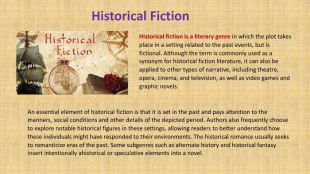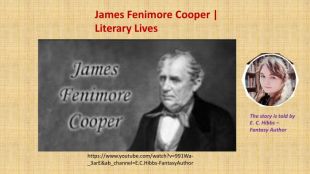Жанр історичного роману. Фенімор Купер. (Презентація)
















Historical Fiction. Historical fiction is a literary genre in which the plot takes place in a setting related to the past events, but is fictional. Although the term is commonly used as a synonym for historical fiction literature, it can also be applied to other types of narrative, including theatre, opera, cinema, and television, as well as video games and graphic novels. An essential element of historical fiction is that it is set in the past and pays attention to the manners, social conditions and other details of the depicted period. Authors also frequently choose to explore notable historical figures in these settings, allowing readers to better understand how these individuals might have responded to their environments. The historical romance usually seeks to romanticize eras of the past. Some subgenres such as alternate history and historical fantasy insert intentionally ahistorical or speculative elements into a novel.
Historical Fiction. Works of historical fiction are sometimes criticized for lack of authenticity because of readerly criticism or genre expectations for accurate period details. This tension between historical authenticity and fiction frequently becomes a point of comment for readers and popular critics, while scholarly criticism frequently goes beyond this commentary, investigating the genre for its other thematic and critical interests.
In the era of romanticism, the historical novel became one of the most widespread literary genres, which was caused by a deep interest in historiosophy. For a realistic historical novel of the 19th and 20th centuries faithfulness to the historical truth does not exclude addressing the topical problems of our time. Because of that, the historical novel often fulfills a certain ideological purpose. Historical Fiction* historiosophy = the philosophy of history. Sometimes a historical era is just a background for depicting current events. The modern historical novel is characterized by convergence with other types of novels — adventure, psychological, etc. His language, as a rule, is somewhat archaic.
Historical fiction as a contemporary Western literary genre has its foundations in the early-19th-century works of Sir Walter Scott and his contemporaries in other national literatures such as the Frenchman Honoré de Balzac, the American James Fenimore Cooper. However, the melding of "historical" and "fiction" in individual works of literature has a long tradition in most cultures; both western traditions (as early as Ancient Greek and Latin literature) as well as Eastern, in the form of oral and folk traditions (see mythology and folklore), which produced epics, novels, plays and other fictional works describing history for contemporary audiences. Honoré de Balzac (1799 – 1850),a French novelist and playwright. James Fenimore Cooper (1789 – 1851),an American writer
The first real historical novel was created by Walter Scott ("Waverley", "Rob Roy", "Ivanhoe", "Quentin Doward"), who managed to combine historical fact with artistic fiction, while using both romantic and realistic methods of depiction. This type received the name "Walterscott" and had a great influence on the development of the historical novel in European literature. Nobody has done more to give a nation a sense of itself. Through the mines of his imagination and the magic of his pen, he celebrated the history and landscapes of Scotland in a string of best-selling books that dominated the 19th century.{5 C22544 A-7 EE6-4342-B048-85 BDC9 FD1 C3 A}In 2021-22 Scotland celebrates the 250th anniversary of one of its most famous sons, Sir Walter Scott.
Otsego Hall, Cooper's home. He lived most of his life in Cooperstown, New York, which was founded by his father William on property that he owned. Cooper left a very large literary heritage. In addition to his 32 novels, he also wrote a history of the United States Navy and many articles and pamphlets on social problems. He also wrote 10 volumes about his travels in the European countries of France, England, Germany, Switzerland, Italy and Sweden, in which he described the natural scenery of these countries and dealt with the history of the people. James Fenimore Cooper
Habits and the dangers of the frontier, the war of the southern and northern states, conflicts with the Indians were inexhaustible sources of an evolving genre of historical and adventure literature. James Fenimore Cooper was among the first outstanding representatives of this trend. Due to his novels European audience acquainted with the life of the Indians, with the dangers and difficulties of life of the American colonists. James Fenimore Cooper
Frontier ( - «boundary line") in the history of the United States is the zone of the Wild West, located in what is now North Dakota, South Dakota, Montana, Wyoming, Colorado, Kansas, Nebraska and Texas, which gradually expanded and moved on as far west as the Pacific coast. The US Census Bureau defined the frontier as a limit beyond which population density was less than 2 people per square mile.the first Fort Laramie as it looked prior to 1840 James Fenimore Cooper
Cooper's work, particularly The Pioneers and The Pilot, demonstrate an early 19th-century American preoccupation with alternating prudence and negligence in a country where property rights were often still in dispute. James Fenimore Cooper Cooper was one of the early major American novelists to include African, African-American and Native American characters in his works. Often, he gives contrasting views of Native characters to emphasize their potential for good, or conversely, their proclivity for mayhem. Last of the Mohicans includes both the character of Magua, who fearing the extinction of his race at the hands of the whites savagely betrays them, as well as Chingachgook, the last chief of the Mohicans, who is portrayed as Natty Bumppo's noble, courageous, and heroic counterpart. And his literary characters. In particular, Native Americans play central roles in his Leatherstocking Tales. However, his treatment of this group is complex and highlights the relationship between frontier settlers and American Indians as exemplified in The Wept of Wish-ton-Wish, depicting a captured white girl who marries an Indian chief and has a baby with him, but after several years is eventually returned to her parents. In 1831, Cooper was elected into the National Academy of Design as an Honorary Academician.
Statue in Cooperstown, New York. The social idea of his novels is to show that patriotism is the most unselfish emotion in human nature, and that the best in man flourishes at the most critical moments. James Fenimore Cooper Cooper was honored on a U. S. commemorative stamp, the Famous American series, issued in 1940 Cooper was one of the more popular 19th-century American authors, and his work was admired greatly throughout the world.
Questions for discussion. What is an essential element of historical fiction?Why are the works of historical fiction sometimes criticized for?Is faithfulness to the historical truth always present in the works of historical fiction?Who was the first who managed to combine historical fact with artistic fiction in the 19-th century literature?What can prove a long tradition in most cultures of melding "historical" and "fiction" in individual works of literature? What did James Fenimore Cooper depict in his novels?What literary heritage did Cooper leave? What is the novel "The Spy” about and what is its social idea?


про публікацію авторської розробки
Додати розробку
















